(Held at Florence, Italy, on Nov. 3-5, 2004)
Dec. 12, 2004
[Posted on Dec. 14, 2004] [Slightly updated on Dec. 21, 2004.]
Editor's
Note (Toru Nakagawa, Dec. 12, 2004)
This is a personal report of ETRIA TRIZ Future Conference held a month ago. (See ETRIA Official Web site.) 125 people attended at the conference and presented/discussed a wide range of TRIZ research and applications. Summarizing and reviewing important papers and activities in such a conference should be of interest and worthy of learning for many people who are interested in TRIZ, I suppose. Thus, I have written a personal report of the conference and am posting it here in my Web site, as I did so far for all the TRIZ conferences I attended (See ETRIA TFC2003and TRIZCON2004
). Even though I have tried my best to understand and review the papers in a fair way, please regard this as a personal view and please correct me if there is any mistake/misunderstanding in this report. Please note that the copyrights of all the figures cited in this report belong to the original authors of the presentations. I wish to thank ETRIA, Dr. Gaetano Cascini, and all the authors who gave me permissions for citing their figures here.
| page
top |
Outline |
Overview |
A.
Keynote |
B.
Case Study |
C. Methods |
D. Knowledge and IP |
| E. Innovatin in industries | F. TRIZ Theory | G. TRIZ Education | H. New Opportunities | Concluding Remarks | List of Papers |
| ETRIA Web site | Apeiron Web site |
Personal Report ETRIA2001 | Personal Report ETRIACon2002 | Personal
Report ETRIA TFC 2003 |
TRIZCON2004 | Nakagawa's
Paper |
Japanese
page |
Conference Name: ETRIA World Conference: TRIZ Future 2004
Main Theme: Integration of TRIZ with other methodologies/tools and the dissemination of systematic innovation practices even through Small and Medium Enterprises.
Date: November 3-5, 2004
Place: Convitto della Calza, Florence, Italy
Held by: European TRIZ Association (ETRIA)
Organized by: European TRIZ Association, (Web site: http://www.ETRIA.net/ )
Italian TRIZ Association (Apeiron) Website: http://www.apeiron-triz.org/en/index.html, and
Dipartimento di Meccanica e Technologie Industriali, Universita degli Studi Firenze
Participants: 125 people from 22 countriesOutline of the Agenda: 1 Tutorial Lecture, 2 Keynote Speeches and 36 Presentations in single track from 8:30 through 17:30 for the three days.
Overview:
This is the
Fourth
World
Conference on TRIZ organized by ETRIA (European TRIZ
Association).
The first one was held at the University of Bath, UK (See my personal
report of ETRIA TFC2001 ), the second at ENSAIS University at
Strasbourg,
France (personal report
of
ETRIA2002
),
and the third at RUTH
University,
Aachen in Germany (personal report
of
ETRIA2003
).
This year it was held at a meeting facility in
the city of Florence, Italy.
University of Florence (Universita degli Studi di Firenze, Dipartimento dei Meccanica e Technologie Industriali) is the core of the organization, and Dr. Gaetano Cascini devoted himself as the key person for realizing this conference.
The total number of participants was announced to be 125 according to the organization committee. Participants came from the following 22 countries: Italy (56), USA (9), France (8), Netherlands (6), Korea (6), Austria, Germany (5), UK, Hungary (4), Belgium, Russia (3), Czech Republic, Israel, Mexico, Japan, China (2), Croatia, Ireland, Poland, Portugal, Rumania, and Switzerland (1). This number is significantly larger than the previous ones and even the expectation by the organizer. A factor of success stems from the thoughtful arrangement of the first day program, i.e. tutorial plus presentations of case studies, which were co-organized with Italian TRIZ Association and were simultaneously translated into the Italian language. It is also reported that 67 people came from academic world in comparison to 58 people from enterprises and consulting companies. Such a big contribution from academia seems to be unique in Europe, in contrast to in USA and Japan. Spreading of TRIZ into various countries can be seen from the above figure; it should be noticed that far-away countries like Korea, Japan, China, and Mexico have given multiple presentations.
Tutorial
lecture was given by Valeri Souchkov
for 3 hours in the morning of the
first day. The symposium
started after lunch with presentations of
case studies. On the second day, we had a Keynote Speech by
Victor Fey for 60 minutes and 16 oral presentations for 20 minutes
each. In the evening we had a special visit to Leonardo da Vinci
Museum and had a dinner till midnight. On the third day, a
Keynote Speech by Hans-Juergen Linde and 12 oral presentations were
given. Since the whole program was arranged in a single truck,
it
was nice to be able to attend at all the presentations, but the time
(20 minutes) for each presentation was too short for me to understand
the essence and discuss the points.
The Proceedings was published in a
book of 530 pages. The
list of the papers in the Proceedings
are shown at the end of this
page. Oral presentations were given basically in the order in the
list; but a number of papers were not presented (as shown with the "--"
marks in the list) and were replaced with the papers in the section of
'Posters and extended abstracts' and those listed as 'Supplementary
papers'. In
this review the papers are referred with
the numbers in this list as shown in [ ].
Topics of
the
presentations
cover a wide range, but the sessions were arranged nicely in accordance
to the
relevant topics, and especially "in an increasing expertise order"
accordin to the organizer. Thus in this report, I will
review the two
Keynote Speeches first, and then review all other papers session by
session in the order of their presentation as follows:
(A) Keynote Speech
(B) Case Studies
(C) Methods Integration and Interactions
(D) Knowledge and Intellectual Property Management
(E) Innovation Strategies: from SMEs to World Wide Corporates
(F) Development and Implementations of TRIZ Theory
(G) TRIZ Education
(H) New Opportunities & Fields of Application
Some Concluding
Remarks are described after these reviews. (The Tutorial is
not reviewed here, since I did not attend it.)
(A)
Keynote
Speech
The first Keynote Speech [L.1] given by Victor Fey
(a TRIZ Master, USA)
was most controversial in this conference. Asking himself 'Why
does TRIZ fly but not soar?', he discusses about three arguments.
They are: (1)
'Corporation can do without TRIZ'. (2)
'TRIZ is complex'. and (3) 'TRIZ is
non-democratic'.
Concerning the argument (1), he tells a
few anecdotes and
observations of just lip-services of company executives.
On argument (2)
'TRIZ is complex': He accepts that this gripe comes from
virtually all corporate TRIZ students and TRIZ consultants. Thus
he examines the ideas of reducing TRIZ into its "bare bones". He
says "SIT and its derivatives (ASIT and USIT) are oversimplifying TRIZ,
and it's not TRIZ any more." One issue is the Su-field analysis,
on which he writes "Simplification of TRIZ by removing Su-field
analysis
deprives it of an important functionality." Another
issue is ARIZ having few dozen steps. He writes "Both steps of
ARIZ and rules for applying these steps, clarify not only what to do to
solve a problem, but also instruct us how to do it. The more
steps and rules there are in ARIZ, the more reliably it prods the
problem solver to a good solution." He also writes: "The
skillful and appropriate use of ARIZ, of the Su-field analysis, and of
other comprehensive methods of TRIZ significantly enhances
effectiveness of the concept generation process -- and, by extension,
customer satisfaction." and "TRIZ, as any comprehensive discipline,
takes too long to master."
On argument (3) 'TRIZ is non-democratic':
From the experiences of very long and extensive experiments on TRIZ
education in the former USSR, i.e. teaching students and engineers in
intensive training courses for 2 to 3 weeks, he has observed that
no
more than 10 % of the students used TRIZ on a regular basis after
completing their education.
His conclusion was "TRIZ is good. Distribution of TRIZ is
bad. Don't touch TRIZ!!" Then he recommends the
distribution of
TRIZ in the three main channels: (a) Basic training to develop a
general awareness of the methodology, (b) Development of small in-house
TRIZ consulting groups, and (c) Growth and formation of professional
consulting TRIZ firms.
Simon Litvin, also a TRIZ
Master (GEN3 Partners, USA),
responded against the speaker saying "I am going to touch TRIZ.
TRIZ for business problems is necessary." Litwin also
demonstrated in [8.4] a
much simplified process (in place of ARIZ) for solving technical
problems.
It should also be noticed, I think, that many TRIZ
researchers
are not 'removing' Su-field analysis but 'replacing' it with some form
of functional (and attribute) analysis. Simon Litwin told me that
he introduced functional analysis into TRIZ but Mr. Altshuller did not
like it and used Su-field analysis without the term of 'function' for a
long time but Mr. Altshuller eventually accepted the idea of functional
analysis. Nowadays the concept of Function is regarded as one of
the
philosophical pillars of TRIZ. We, especially leaders and
researchers of TRIZ, should remember, I believe, that TRIZ, as any
technical
system, has been and will be evolving toward its ideality. You
see a number of presentations in this conference are actually touching
(traditional) TRIZ to improve it from various perspectives.
In the evening of the day, during the dinner time, I discussed (or
argued) personally with Victor Fey concerning USIT. USIT is not a
'simplification by truncation' of TRIZ but a 'simplification by
unification and introduction of a new framework (or structure)'.
New generation of TRIZ (as any technical system) needs introduction of
new concepts. We should discuss which new concepts are
appropriate or not. We should certainly touch TRIZ for further
innovation of TRIZ itself.
By the way, Fey's three proposals for distributing TRIZ seems to
coincide with my proposal (in 1999) of "Slow-but-Steady Strategy" of
introducing
TRIZ into Japanese industries except the issue whether to
simplify TRIZ
or not.
The
second Keynote Speech [L.2] was given by HansJuergen Linde
(with a nicely coordinated play by Gunther Herr).
As I wrote in my report of
ETRIA2002, he and his group have a long
history of applying
TRIZ since the days of East Germany. Their model of spiral
evolution and its inevitable bottle necks (or contradictions) is
illustrated in the figure shown below.
Their strategy for
innovation covers a very wide scope yet focuses on the resolution of
contradiction, as you can see in the figure below. Their
methodology, named
WOIS (i.e. Contradiction Oriented Innovation Strategy), has much
successful experiences for about 15 years in German industries.
(B) Case Studies
In
the afternoon of the first day, two sessions were devoted for nine
presentations of practical case studies, with the intention of smooth
and easy introduction of real applications of TRIZ even to beginners of
TRIZ.
Siegfried Luger
(a consultant, Austria) [1.1]
reported the case of developing a helmet for Formula 1 drivers.
The problem is that when a racing driver comes out of a tunnel to a
brilliant sunny place his eyes can not adapt well for a few seconds and
the fatigue accumulates in his brain. For overcoming this problem
the author derived the concept of a 'lighting helmet', which shows blue
lights
in the driver's field of vision for a short time before coming out of
the dark
place. The concept needs some further development for
implementation, the author says.
Vinicio Tresin
and Licia
Pengo (consultants, Italy)
[1.2]
presented a case they worked with a tiny farm company. They wash
vegetables, like spinach, and pack them in plastic bags for
selling. The company thought it should be nice if the washed
vegetables can be cooked in the microwave oven without taking out of
the plastic bag. The authors assisted them to survey the existing
method and to invent a new package. The new plastic bag has dual
sealings, namely strong sealing with a small path way and an outer weak
sealing which can release the vapor pressure when heated in the
microwave oven. The bag may have a part for containing a small
amount of water for better cooking other kinds of vegetables.
"TRIZ can be used in any tiny company if some assistance is available",
this is the main message from the authors.
Manfred Peritsch
(IMG Innovation Management Group, Austria) and Hans Lercher
(Fachhochschule
der Wirtschaft Graz, Austria)
[S.1]
reported the result of the ISAAC
Project for promoting TRIZ based
innovation management in SMEs (small and medium-sized
enterprises) with the fund from Austrian Government. With
the intention of arranging existing TRIZ tools to match Austrian SMEs,
IMG decided to focus on the trends of evolution part of TRIZ and
evolutionary potential radar chart developed by Darrell Mann and
CREAX. The following figure (new English version, by courtesy of
the author) shows the ISAAC product concept
development process, consisting of 5 phases.
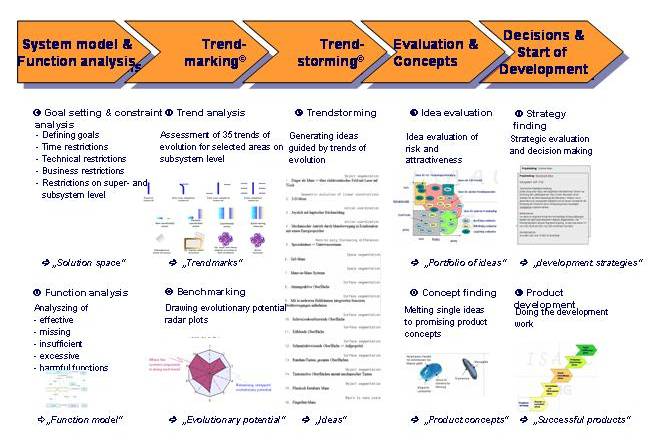
The 5 phases are: Phase (1):
In a discussion between responsible managers and the consultant, the
project goals, resources and constraints are defined. Then in a
1/2 to 1 day workshop with a small team of experts involved in the
project, system modeling and function analysis are carried out.
Phase (2): With a larger team of internal and external experts,
evolutionary
potential radar plots (1 to 4 plots) are drawn. Phase (3): With
the same
team in Phase (2), brainstorming sessions are performed using the
trends of
evolution as a guideline. This is done in 1-3 workshops and is
the most creative part of the whole process, resulting a large number
of
ideas. Phase (4): Then the ideas are filtered with the
portfolio-type
criteria of innovation potential vs. cost for realization (about 25
ideas can be sorted per hour into four
classes). For top ideas and question mark ideas,
responsible persons are defined for further work of in-depth
analysis. (5) Then,
in the final workshop, the evaluated ideas are presented to the
decision
makers, who are requested to make decisions how to proceed with every
single ideas.
In
this project having 15 industrial partners, 5 real problems were solved
as pilot cases. A case in a shoe manufacturing company was
reported in some detail. In the 5 cases, 125-250 ideas each were
generated, and well above 50 % of them were found valuable.
Though product concept development is an unknown field for many
managers,
the results of the pilot projects were well accepted by the managers, the authors reported. -- The experiences of the ISAAC project
should be learned widely.
Daniele Regazzoni,
Caterina Rizzi (Univ. of Bergamo, Italy), and Nicoletta
Loacatelli (SCINTE, Italy)
[1.4]
presented their case studies of incorporating TRIZ into the PLM
(Product Lifecycle Management) activities in industries.
One of the cases handles technical problems in the textile industry for
improving the mechanisms of the weaving looms. Functional
analysis, trimming, and ARIZ have guided the problem solvers to some
drastic change in design of some parts of the weaving loom, whose
details will be disclosed in a few months in the patents. Second
of the cases handles the quality and risk management in a medical
manufacturing company. The authors introduced the TRIZ-based
approach, in particular AFD (Anticipatory Failure Determination), and
used it together with FMEA (Failure Mode and Effect Analysis).
-- This report nicely shows the collaboration work of university
researchers, consultants, and industry people, in Italy.
Kyeong-Won
Lee (Korea Polytechnic Univ.) [1.5] has presented a lovely
case study of
applying TRIZ to invent a new type of 'Mosquito Traps'. After the
hot summer in 1998, one of his undergraduate students proposed the
problem to invent some method to protect human from mosquitoes.
So they described the problem in the Su-field model, as in the
following figure.

Then
a standard solution in TRIZ suggests to insert some additive which
should be a modification of either S1 (mosquito) or S2 (human). [A figure of the Su-field model will be
inserted here later.]
With a help of expert knowledge that
mosquitoes are attracted with the CO2 gas from
human, they
started to think of the method to generate CO2 gas as cheaply as
possible. Their solution is to use a photocatalist TiO2
excited by
ultraviolet lamp for converting dirty air (including a small amount of
organics) into CO2 + water vapor. Then they
built up prototpes of Mosquito Traps with the functions of generating CO2, of
sucking the attracted mosquitoes with an air flow, of killing them
by cutting with rotary blades, etc. This development was done in
a small venture company, KID (Korea Item Development), for which
Professor Lee himself is the CTO. The model is shown in the following
figure.
A prototype trap captured 10 thousand mosquitoes in one night near a
cattle shed in Korea in summer, they reported. The model received
a bronze medal in IENA2000 (a German international invention
competition) and is now pending for patents internationally.
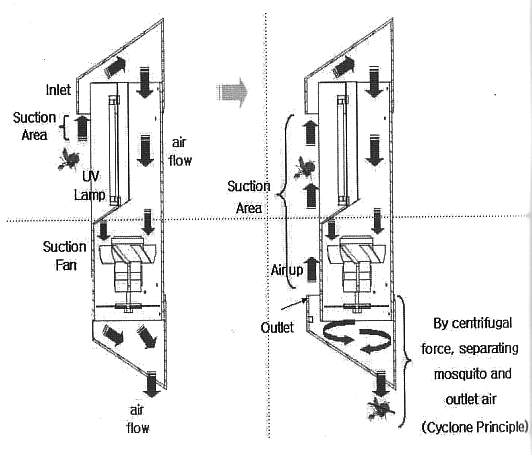
-- I
was very much amazed with this case study, just as the preceding paper
by the same author on the 'Super water-saving toilet' which appeared in
the TRIZ Journal and reposted in
Japanese translation in my Web
site. Problems are taken from everyday
life and are important
world wide; a basic TRIZ method is applied at the key point of the
solution (or elegantly explained as such); the solution concept has
been refined by building prototypes; and patents have been
applied/obtained internationally. It is remarkable that these
case studies were developed 5 to 6 years ago in South Korea, probably
reflecting their sound basis of understanding the essence of
TRIZ.
Mateusz
Slupinski (Wroclaw Univ. of Tech., Poland) [1.6] has presented a case
study of applying laws of system evolution to a problem of thermal
insulation in a building. The problem is to reduce the heat flow
from a warm room to the cold outside air, especially through the heat
bridge formed at the junction between the floor slab and the external
wall. Various ideas were developed by applying laws (or trends)
of system evolution, and the solution of attaching a thermal insulation
panel at the edges of the ceiling was found most effective and
practical. Since the solution itself is well known among the
professionals, the point of this paper should be demonstrating the ways
of applying trends of evolution; but the ways of application do not
seem so effective/attractive for me.
Simona-Mariana
Cretu (Univ. of Craiova, Romania) is a researcher in robotics
and
reported [1.8] her
recent study of making a multi-legged locomotive
robot. She has taken a model from a millipede 'Litobius
forficatus'. First she made video images of the animal locomotion
under microscope, but she could not understand the motion
mechanism. Then, using the principle "the other way round", she
put the millipede on a slippery glass; the millipede moves legs but its
body does not move. With such an observation she understood the
animal's motion of body segments and legs, and made a simplified model
of the locomotion. Then she made prototype systems of
multi-legged
robot. In implementing the robots she used a number of TRIZ
principles mostly guided with the contradiction matrix. She says
she is just a beginner of TRIZ, but she seems to be using TRIZ
principles actively in her own study of robotics.
Edgardo
Cordova Lopez and Maribel Lastrini
Arroyo (Benemerita Universidad
Autonoma de Puebla, Mexico) [1.9]
reported that Value Analysis (VA or
VE) and TRIZ are emerging in Mexican industries. They have shown
a case of improving the paddles for extracting excess run-off
of the molten metal oven. The traditional flat paddle
has been redesigned into the ones of parabola shape with a big hole in
the middle for passing the molten metal through. The number of
paddles being exhausted per day of operation has reduced from 25 into
5,
resulting the annual savings of 15 thousand dollars.
(C) Methods Integration and Interactions
Michael S. Slocum
(Breakthrough Management Group, USA) [2.2] discussed
on 'Innovation in Performance Excellence' and proposes '8 paradigms to
performance excellence'. His model is hierarchically
composed of foundation, base (assessment methodology), and a
progression of methodologies (i.e. strategic planing, process
management, lean, process improvement (Six sigma), design (DFSS), and
R&D). He writes "In order for an organization to excel from
conceptualization to commercialization a number of core competencies
must be present. Not only do these capabilities need to be
present but they need to be fully integrated". Thus he suggests 8
paradigms, where the capabilities in his hierarchical model
progressively appears and gets matured. -- But I do not
understand why the methodology of the
top-ranked R&D capability can appear suddenly at the 8th paradigm.
The paper written by Darrell Mann
(Systematic Innovation Ltd., UK) [2.1]
was orally presented by Ellen Domb. Mann discusses about
'Philosophy-level integration of TRIZ into an integrated business and
management innovation process'. This seems to reflect his new
book
"Hands-On Systematic Innovation for Business and
Management". His discussion on the
conflicting needs of 'complexity' and 'simplicity' is most
interesting among
several conflicts at philosophy level. The last two paragraphs of his
paper is quoted here:
Jack Hipple
(Innovation-TRIZ, USA) [2.3]
proposed "Integration and use of TRIZ with other innovation and
creativity tools". In USA and many industrial countries, when
TRIZ methodologies are brought into an organization, there often is an
existing infrastructure of problem-solving tools and
methodologies. They include brainstorming, creative problem
solving (CPS), Six Hats and Lateral Thinking, and mind mapping.
The author briefly summarizes the uniqueness of TRIZ and its tools in
comparison with the existing ones, and proposes to incorporate TRIZ
concepts and tools with the existing ones. The ways
of integration of TRIZ with the Creative Problem Solving (CPS) process,
with DeBono's Six Hats process, and with Lateral Thinking,
respectively,
are described in some detail in the paper. -- This strategy and
guidelines
seem to be useful in many real industrial situations.
Sergei Ikovenko
(GEN3 partners, USA) and Jim Bradley
(International Truch & Engine Corp.) [2.5]
reported with the title of "TRIZ as a lean thinking tool". It was
impressive to see that (since Ikovenko possesses a number of positions)
he
talked various parts actually wearing different hats, including GEN3,
MA TRIZ, MIT, and Sergei himself. Lean thinking was originally
developed in Toyota's manufacturing operations in 1970s. It tries
to use less of everything - human effort, capital investments,
facilities, inventories, and time - in manufacturing, product
development, parts supply and customer relations. The paper
describes how the TRIZ methods (especially TRIZPlus, see Litwin [8.4]) can be
incorporated in the Lean Thinking process. Conclusion of the
paper is quoted here:
Young Ju Kang,
Alexander Skuratovich, and Pyeong Kwan Chun
(LG Cable, Korea) [2.6]
reported the combined use of Axiomatic Design and TRIZ. LG Cable
have tried to introduce TRIZ since 2001. Their particular
strategy presented here is to use Axiomatic Design for defining the
design
problem and to apply TRIZ for solving the problem and for developing
new design concept. A case of improving tensile strength of
polymer insulator for holding high voltage power cables at the tower is
reported. The structure of the present insulator is shown in Fig.
(a) below. For tightly holding the FRP (Fiber Reinforced Plastic)
rod, the fitting metal is compressed with a die in its manufacturing
process. For enduring larger tensile strength of the cable,
higher compressing force is necessary but it sometimes causes a
crack in the FRP rod as shown in Fig. (b) [Note: Need to change the
sides to match with Fig. (a)]. With the aid of
Contradiction Matrix and Inventive Principle "Segmentation", they have
found the solution as shown in Fig. (c). The loose body put
between the FRP rod and the fitting metal distributes the compressing
pressure uniformly. -- But my question is: why do they depend on
the friction force with the straight end of the FRP rod? Isn't it
possible to redesign/deform it into a thicker end?
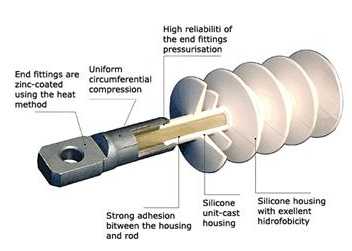

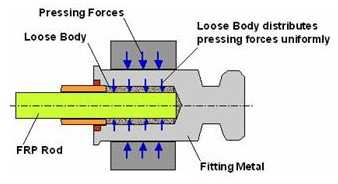
(D) Knowledge and Intellectual Property Management
Minyi Zhang
(IWINT, P.R. China), coauthoring with Serge Pesetsky and Haibo Duan, [S.2] presented their
approach to developing a TRIZ-based software tool named
Pro/Innovator. This software company, having its main office in
California and a branch in Beijing, is developing the tool for
assisting
engineers in the conceptual design stages of product development.
For the problem definition stage, they provide a tool for
cause-consequence analysis enhanced with multi-screen scheme of
TRIZ. Its scheme around an undesirable event is shown in the
following figure:
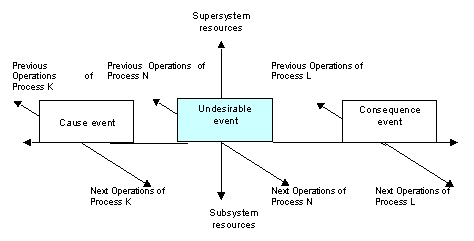
In the problem solving stage,
user's query for accessing the knowledge bases is supported by a
linguistic processor and an ontology processor, the authors say.
The software itself was not demonstrated in the presentation.
Guillermo Cortes
Robles,
Stephanie Negny,
and Jean-Marc Le Lann
(INPT-ENSIACET, Toulouse, France) proposed a model where
TRIZ and Case-Based Reasoning (CBR) are combined for building and
utilizing a Knowledge Management system. Since ordinary CBR
searches for solutions in a single domain, enhancing it with TRIZ
is expected to be helpful to search for solutions in different
domains. Their scheme is shown in the following
figure. -- Practical effectiveness of this model still need to be
demonstrated.
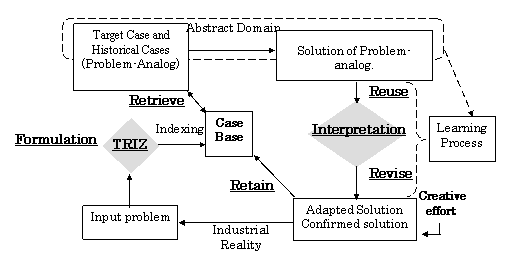
Gaetano Cascini (Universita degli Studi di Firenze, Italy) and Federico Neri
(Synthema S.r.l., Italy) developed a set of tools for extracting
knowledge from patents. A prototype software tool, PAT-Analyzer,
analyses the patent documents and automatically draws a functional
diagram
with hierarchical representations of components in the system.
Further using the hierarchical classification of the components,
the core topic of the patent can be identified and the contents of
paragraphs in the patent can be evaluated with its depth of detailed
description. A third tool is for
automatically classifying a large number of patents in their
topics. Over 200 patents related to airbags and car clash tests
were analyzed automatically with the tool, giving the figure as shown
below. The fourth tool supports multilingual searches of patents,
recognizing five natural languages (i.e. English, German, French,
Italian, and Spanish). This part was funded by WISPER, an EU
research project, and is now extended further, the authors write.
(E) Innovation
Strategies: from SMEs to World Wide Corporates
Valeri Souchkov
(ICG, The Netherlands) [4.2]
discussed on the innovative enterprise
infrastructure on the basis of his experiences and reflections of
promoting systematic innovation (including TRIZ as a part) and its IT
support (with knowledge bases and some logical procedures). He
summarizes in the figure, shown below, that the following four major
components must
be established evenly as the innovation infrastructure of an
enterprise. The core innovation team is the key of first
importance, which should accumulate expertise and experiences in
systematic innovation and activity. He points out that formal
methods and informal ways of thinking should be well balanced.
The second key is the management of the whole life cycle of
innovation, from recognition of specific problems and situations
(demanding for innovation) to successful implementation of innovative
ideas. Without such management, good ideas are so often
lost because of minor problems or seemingly high risks. The third
key is the knowledge sources, while the fourth is the IT support, as
shown in the figure.
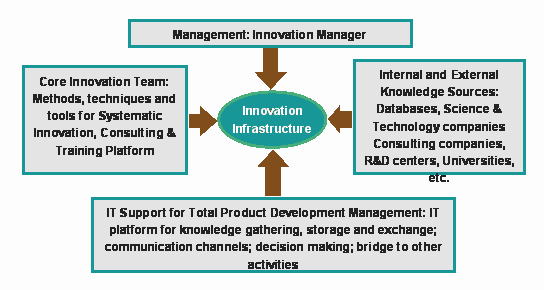
His
remark in the conclusion is worthy of quoting here:
Elies Dekoninck
(Univ. of Bath, UK) and Paul Frobisher
(Avon Automotive, UK) [4.3] reported
about the current situations of "TRIZ champions" in UK industries on the
basis of interviews to about ten such people. The interviews
revealed two different types of them. Type 1 TRIZ champions are
bottom-up self-appointed TRIZ enthusiasts, demonstrating TRIZ through
case studies, and mostly having 6-8 years of TRIZ experiences
already. Type 2 TRIZ champions are top-down formally-charged
mid-managers, orchestrating introduction and institutionalization of
TRIZ in the company. The latter type is a rather newly emerging
phenomenon,
and they currently have less than 2 years of experiences. The
following
figures show examples of organizational environments and TRIZ
champions' spheres of influence. The current situation in UK is
that the Type 1 TRIZ champions are not yet fully authorized in their
TRIZ activities in the companies, the authors reported.

Ellen Domb,
the Editor of the TRIZ Journal, together with Arthur Mlodozeniec
(TechniPharm C.G.,
USA),
a top leader in pharmatheutical technology, [1.3]
reported a collection of case studies of applying TRIZ to
pharmaceutical industry. The main goal is to accelerate the
successful progress (i.e. 'technology transfer' in the pharmaceutical
industry) from drug discovery to product development to clinical trials
to full-scale commercialization. For solving various problems
appearing in these interfaces, basic TRIZ concepts have been
applied. They include increasing ideality, elimination of
tradeoffs, and elimination of inherent (physical) contradictions.
A collection of successful case studies have demonstrated that the
skills of beginner-level TRIZ can make substantial contributions to the
problem solving in the pharmaceutical industry, where medical and
biological aspects are important in addition to physical and chemical
ones. -- Also see Ellen Domb's paper presented last year at ETRIA TFC2003 ,
having
the same motive of successful application of beginner-level TRIZ.
Bernard Monnier
(THALES Research & Technology, France) [4.5] tries to apply TRIZ to
business management activities. Though the application method
seems to need demonstration yet, the following figure is interesting
to me. Products may be evaluated with respect to the technical
level and to the market level (the evaluation method is not shown), and
may be discussed in this portfolio-type diagram; the author named it
'Monnier's
Innovation Matrix'.
Paul Frobisher
(Avon Automotive, UK), and
Elies Dekoninck, Tony
Mileham, and Julian
Vincent (Univ.
of Bath, UK) [4.6]
presented a model and a metric for benchmarking the innovation profile
in a company. They used a system-modeling tool called IDEF0, and
expressed the top level model of innovation as shown in the following
figure. Thus their definition of innovation is 'the process of
adding value by adapting and furthering available knowledge, to satisfy
business and customer constraints at minimal cost'. Their metric
of innovation is composed of five-level descriptions with respect to
commercial potential, inventiveness, added value/cost (effect
upon contribution or direct profit), cost (investment, development
resource, timing), and risk. Applying these metrics
to patents is expected to reveal some profile of innovation activities
in historical time scale and in company/division space; but this needs
further demonstration.
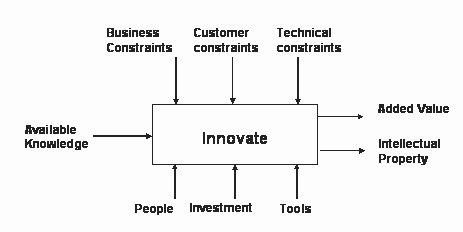
Manabu Sawaguchi (SANNO Institute of Management, Japan) [4.7] reported two points; a survey of R&D activities in Japanese industries and the introduction of TRIZ methodology in the new product planning. (Unfortunately in his talk he spent too much time in the first, less important part.) The author's group has been consulting with the VE method for many years and has introduced TRIZ into the planning stage of new products. The author's new process unifying VE and TRIZ-DE is shown with an example applied to 'panels to be used in the bath room, kitchen, etc.' The steps are: (1) collecting information, (2) examining the development history, (3) thinking of future development in the 9 windows scheme, (4) mapping the patterns of technological system evolution to the observations, (5) writing future scenarios and developing concepts for the target system, and (6) evaluating. One scenario for the exemplar case is 'a maintenance-free board' in baths and kitchens.
Jinha Jeong
(Korea Institute of Industrial
Technology (KITEC), Korea) [8.3] reported
the current active initiatives of Korean government through KITEC, a
national laboratory specially dedicated for supporting R&D in small
& medium-sized enterprises (SMEs). KITEC has set up the TRIZ
Task Force in early 2004. With the support of Ministry of
Commerce, Industry and Energy (MOCIE) and of Samsung TRIZ Association
(STA), KITEC has quickly set up its operations in the following four
categories: Consulting SME companies with TRIZ (either by KITEC
or outside TRIZ experts), TRIZ education for engineers, TRIZ R&D
(especially development of TRIZ software tools in Korean language), and
holding TRIZ conferences. -- It is really amazing that in
Korea the
TRIZ activities seem to rapidly growing in big businesses (especially
Samsung and LG), universities, and government and SMEs.
Avraam Seredinski
(Higher Institute of
Conception, Innovation and Simulation (ESICS), France) and Vissarion Sibiriakov
(DIOL Company, Russia) [8.2]
has pointed out that for inculcation of TRIZ different approaches and
different presentations of TRIZ are appropriate/necessary in different
firms. They show the Ideal Final Result of TRIZ propagation as:
"All the employees of all
the firms know (all of) TRIZ" [ ( ) inserted by Nakagawa]
and then set back step by step as:
"All the firms use (all or
some part of) TRIZ" [( ) inserted by Nakagawa]
"In each firm somebody knows
(or uses) something about TRIZ" [( ) inserted by Nakagawa]
Then they discuss that various structures and situations need to be
considered in both the firms and the TRIZ sides in the "Firm - TRIZ"
pair of inculcation. They suggested application of TRIZ
principles (like segmentation, local quality, nesting, etc.) for
developing the inculcation strategies. -- This
paper is like an essay, full of important points to be discussed
further, but not
much described yet.
Thomas Eltzer, Denis
Cavallucci, Philippe Lutz, and Nikolai
Khomenko (INSA, Strasbourg, France) [5.1] reported
a theoretical work of representing the relationships of parameters
involved in contradictions. They distinguish two types of
parameters: The first type (called a "physical parameter"
of the contradiction) is a parameter defining the designed
object. If the designer can change it directly at different
levels as his design choice, it is called an "active parameter".
The second type (called a "technical parameter" of the contradiction)
is
used as criteria for evaluating the design project. If it cannot be a
choice and if it can represent constraints, functions, and evaluation,
it is called an "evaluating parameter". By using these
parameters, the pattern of contradiction is typically represented as a
network structure of causal dependencies rooted from active parameters
down to relevant (intermediate and terminal) evaluating
parameters. The authors have derived a few rules to select the
key contradiction from such a sometimes complex network of relevant
parameters.
A case of
designing a mold for manufacturing a plastic part is demonstrated in
the
following figure. In this case, an intermediary technical
parameter 'viscosity of bulk melt' is found the key parameter of
contradiction; the design choices of the two active parameters (shown
in the left) determines this key parameter value, which then determines
the values of evaluating parameters (shown in the right). Thus,
though this problem may be seen as a technical contradiction between
the
two evaluating parameters, it can be basically understood as a
physical contradiction in the 'viscosity' parameter. The authors
regard this method as a tool for
structuring knowledge before tackling the problematic situation.
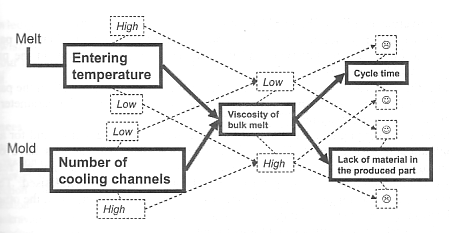
Olga Bogatyreva,
Alexander Shillerov,
and Nikolay
Bogatyreva (Univ. of Bath, UK) [5.2] have
tried to reorganize Altshuller's Contradiction Matrix. Their main idea
seems to introduce the six 'fields of operation' for classifying the
essence of problem or solution. They are:
Substance:
Adding, removing or changing the properties of material.
Structure:
Adding, removing or regrouping of structural parts.
Space:
Changing of spatial position or geometrical form of system or the shape
of its parts.
Time:
Retardation/acceleration of the process, or changing an order of the
actions.
Energy:
Changing energy source or kind of acting field (magnetic, electric,
acoustic, etc.)
Information: Changing the interaction or its regulation
(information exchange) of a system or system elements
Then the authors have classified the
parameters of TRIZ contradiction matrix into these six categories, and
have built a simple 6 x 6 matrix with the framework of 'operation
fields that should be improved' vs 'operation fields that cause
problems'. In each box of the 6 x 6 matrix, there naturally come
in a large number of appearances of 40 Inventive Principles from the
original matrix; so the authors filter them with statistical
significance. Thus they obtained a 'General TRIZ Contradiction
Matrix' having the 6 x 6 framework. -- I still don't see why this
kind of simplification is
desirable and how useful the
result is.
Simon S. Litvin
(GEN3 Partners, USA) [8.4] demonstrated
their approach of simplified yet powerful problem solving in TRIZ (or
the TRIZplus methodology, in
their naming). He
says there is a contradiction within TRIZ itself: seeking for high
level of inventiveness (which often requires dramatic changes in the
design) versus requiring minimal change in TRIZ mini problem approach
for easier implementation. For solving this contradiction, he and
his group developed a new paradigm,
called Function-Oriented Search (FOS). In the new scheme, the problem solver should find
an existing technology (product or process) which best performs the
desired (abstract) function and transfer the existing technology
to the initial
problem as a solution. [This approach was reported in more detail
in TRIZCON2004 (see my review in
this Web site) . Their slogan is:
"No invention is the best invention".] The author writes that the
key components for effective implementation of this methodology are (a)
function-based technology database and (b) global network of
area-based expertise (GEN3 has organized a network of over 7000 subject
matter experts). -- Even with smaller-scale expertise
group,
this approach should be tried with the help of extensive knowledge base
software (a).
Madara Ogot
(Pennsylvania State Univ.,
USA) [5.4]
proposed to adapt modeling methods already familiar to engineering
designers for use in TRIZ. Specifically, he has chosen the
'black-box' modeling technique developed by Pahl and Beitz and adapted
it into the 'Energy-Material-Signal (EMS)' modeling to represent the
problem with TRIZ-based ideas of useful/harmful functions, etc.
He has demonstrated his model in the examples of an airbag system and
an
hard disk drive system.
Toru Nakagawa
(Osaka Gakuin Univ., Japan) [5.5] discussed
about the overall structure of problem solving in TRIZ and in its
simple and unified version, USIT. A common understanding of
problem solving process in TRIZ is the 'four-box scheme', i.e.
generalized problem and its generalized solution should better be
passed through for converting user's specific problem into its specific
solution. However, even though (or rather, because) TRIZ
has developed a large number of models (of generalized problem-solution
pairs), the process of abstracting user's specific problem into a
generalized problem is not well organized, and has multiple paths of
insufficient partial analyses depending on the model selection.
On the contrary, USIT (Unified Structured Inventive Thinking, developed
by Ed Sickafus and refined by Nakagawa) has a clear 'overall procedure'
expressed in a flowchart. And it has been newly recognized that
USIT has a clearly-defined 'overall structure' expressible in the
six-box scheme as follows in the 'dataflow diagram' representation.
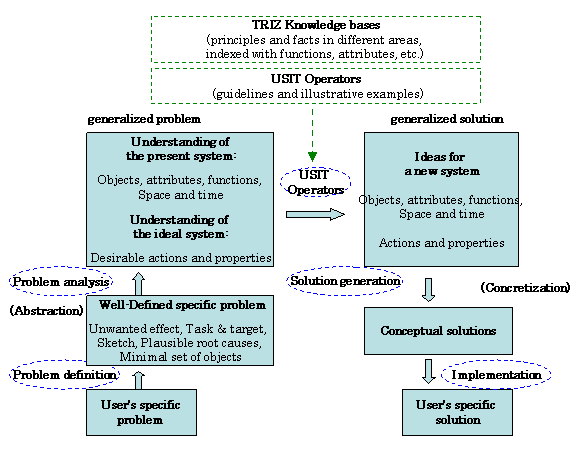
User's specific but vague problem is (1)
converted into a well-defined specific problem in
the problem definition phase, (2) further analyzed to obtain
understanding of the present system and its ideal system, (3) then,
with the application of USIT operators for solution generation,
transferred into pieces of ideas of a new system, (4) built into
conceptual solutions, and (5) finally implemented into user's specific
solutions. 'Generalized problem' in this scheme does not come
from models in the textbooks but solely constructed from the user's
specific problem with standardized analysis procedure. The USIT
Operators, the key tool in the whole procedure, were derived by
Nakagawa
et al (ETRIA TFC 2002) by reorganizing all the methods and
principles in TRIZ. The importance of constructing conceptual
solutions and implementing into real solutions is recognized in this
scheme. Engineering background plays significant roles in the
initial and the final phases, while methodological capability
contributes largely in the intermediate phases. This shows the
importance of cooperation between engineers and methodology experts in
successful cases of real application. I would like to emphasize
that this six-box scheme can be a sound basis for creative problem
solving in general.
Simon Dewulf
(CREAX, Belgium) reported CREAX's approaches to developing handy and
effective software tools for systematic innovation, by combining his
three papers coauthored with Gertjan Otto (CREAX
Netherlands) and Alexei
Bogdanov (Mars LLC) [7.7],
with Gijs
Bakker (CREAX Netherlands) [8.5], and with Matthieu Mottrie (CREAX, Belgium) [8.6].
Firstly, they have integrated Inventive Principles and Trends of
Evolution into a simpler set of 'Inventive Directions', and used the
latter in expressing evolution potential radar chart (with the name of
'Innovation Mapping') and in showing the Contradiction Matrix (or
Matrix 2003) (with the name of Conflict Map for Directions). They
say that these new presentations have already been accepted better in
customers' trial use. Innovation Mapping is demonstrated in the
figure below: [This
figure has been replaced (Dec. 21, 2004).]

Secondly, they have chosen the
common evolution trend 'solid -->
liquid --> gas --> field' as the backbone of combining (or
unifying) a number of trends (or 'directions' in the preceding
paper). They also noticed the importance of recognizing the
opposite (or 'functional symmetry'), such as a powder vs a sponge, a
foam vs a spray. The following figure illustrates their idea of
combinations in space and time of solid and gas. -- Even
though this looks naive in
its idea, it must be very illustrative in creative thinking, I
feel. [This figure has been
replaced. Dec. 21, 2004]
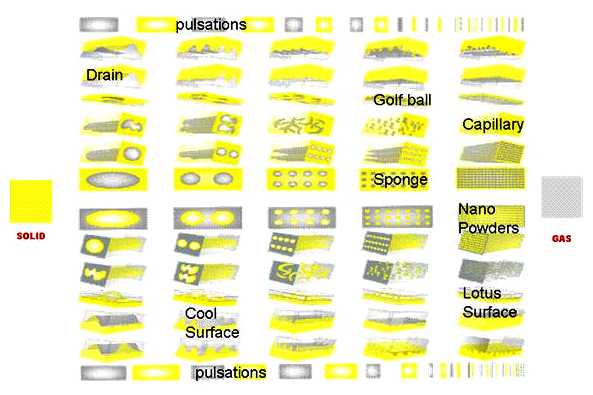
(G) TRIZ Education
Pavel Jirman (Technical Univ. of Liberec, Czech Republic) and Bohuslav Busov (Technical Univ. of Brno, Czech Republic) [6.1] reported their TRIZ teaching experiences in technical universities. Methods of creative technical thinking (TRIZ in particular) have been taught for more than 10 years in Czech Republic. (Busov told me that he found TRIZ in 1983 and studied it in Russian.) In the optional course of 'Theory of Creative Thinking', undergraduate students learn the methodoloy of TRIZ with illustrative cases in the lectures, try to apply them on solved cases in seminars, and finally apply them, more or less independently, for solving their own small projects, semestral design projects or diploma theses. Methodical references have been prepared and software tools (of IMC) are also used after acquiring the basics of the method.
Three cases generated by students
have been reported in the paper. One of them is 'Hand feeding of
molten glass with a blowpipe from a pot furnace'. The solution
process is described briefly in the following terms: (1) Technical
system, (2) Function of the
technical system, (3) Problem (see the left figure below), (4)
Conventional, unsatisfying solutions (see the middle figure, for
instance), (5) Technical contradiction, (6) Ideal solution (which
performs the desirable action
'by itself'), (7) Physical contradiction ('the front edge of the pot
must
be high and must be low'), (8) Conceptual solution, and (9) Technical
idea (see the right figure below). In the technical solution
shown in the figure, the front part of the pot edge is made heavier and
the front part of the pot bottom is made with a slope; thus in case of
a reduced amount
of glass the pot inclines by itself.
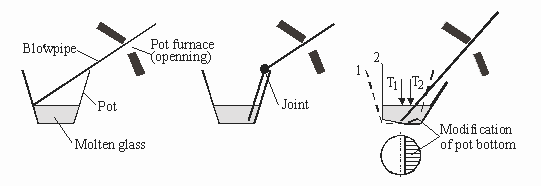
In conclusion, the authors
write the following points of remarks:
(1) In lectures, cases of small problems should follow
every short explanation of theory.
(2) Attention should be concentrated to a few essential
elements of the creative method that change the traditional thinking in
the greatest way. They are mostly in the analytical steps.
(3) Repetition is necessary in lectures and in exercises,
in order to understand that the process towards a creative solution is
relatively the same methodically in spite of the differences in
technology.
(4) Cases related to everyday life are effective.
Lecturers should prepare for using new cases.
(5) For acquiring the methodology, it is most effective
for students to try to solve an open technical problem in a topic on
which they have sufficient amount of required knowledge.
(6) The authors do no suffer from the illusion that all
students are prepared for
the passion to inventive activities. Authors'
experiences show that approximately 10 - 20 % of the students are
willing and
able to overcome traditional thinking and acquire creative thinking.
Juergen Jantschgi
(Univ. of Leoben, Austria) [6.2] reported about the SUPPORT project for
developing a training course on methodical product- and process-development
by combining TRIZ tools
and sustainable development. This project was granted by the
'Leonardo da Vinci program' of the European Union and conducted by 6
development partners and 10 other implementation partners, coming from
6
countries. It aims to develop a methodology for creative R&D
of products and processes in an ecological and sustainable way.
With the emphasis on cleaner production for products and processes,
TRIZ tools have been introduced for the problem analysis and for idea
generation. Starting in the end of 2002, the project has
developed the course (by mostly combining the existing tools) and it is
now in its technology transfer phase; the project will start its wider
transfer trials in October 2004 with partners from 12 European
countries in total.
Norma F. Roffe
(ITESM, Monterrey, Mexico) [8.7] reported
their trial of creative problem solving by students in the course of
microelectronic devices.
For developing digital circuits, nowadays a high-level hardware
description language VHDL is used widely and is taught in undergraduate
classes. Thus,
designing digital circuits for the applications given by professors has
become somewhat a routine work. On
the other hand, various kinds of transducers, sensors, and actuators
are easily available in the markets, and hence the constraints in
making digital electronic
applications almost disappear, the author says. Thus the author
has given to the students the tasks to invent digital applications from
scratch. The methodology is to build a relational schema (in the
sense of relational database theory) of a subset of the observed world
(composed of objects, events, facts, etc.) and to find two objects or
attributes that were not directly related; then, a new digital device
may be introduced to relate the two. This task has
motivated the student much more highly than standard tasks, the author
reported.
Haibo Duan (IWINT, P.R.
China), coauthored with Serge
Pesetsky and Yue Lin, [8.1] reported
their commercial development of a software tool, called CBT/NOVA, for
training in TRIZ. The tool has two courses, basic TRIZ and
advanced TRIZ; the contents seem to be a full course of standard TRIZ
textbook, where Su-field analysis, Inventive standards, and ARIZ are
taught in the advanced course. For each topic, the course repeats
the presentation of theory, examples, and exercises, and then gives
a final test and, for the successful learners, an electronic
certificate. The authors say that their principal trainers have
over 15 years of experiences in training systematic innovation, and
that all the examples and exercises in the software are their original
and not published in TRIZ literature. -- The software was not
demonstrated in the presentation; hence we cannot see how learner
friendly it is at moment.
(H) New Opportunities &
Fields of Application
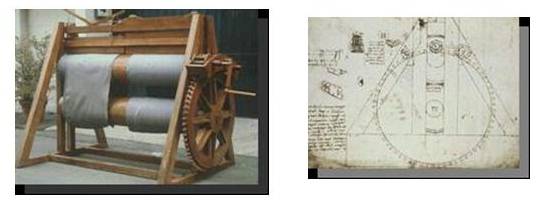
Eight of Leonardo's designs of
textile machines were chosen as the data for the analysis. They
are machines for spinning, weaving, raising, cutting, and
goldblating. The variety of their overall functions makes the
preceding analysis method difficult to apply. (In the authors'
preceding paper, they could analyze the chronological order of several
cranes with reference to the TRIZ trends of evolution.)
Thus the authors applied the TRIZ trends of evolution criteria to
specific parts of the machines having the same subfunctions. They
also used the 9-windows method to consider the super-system and
sub-system situations for the sample machines. The analysis
is still in progress, and the current results are cross checked with
rather limitted historical data. The authors concluded that
Leonardo
used to try 'textile automation', nearly 3 centuries ahead of the First
Industrial Revolution in UK, even though the 16th century technology
was not offering the means to realize it. The studies about the
history of textile processes are quite difficult because the
innovations
at that time were hidden as industrial secrets, in the situation that
there were no rules of
protecting intellectual properties.
Vissarion Sibiriakov (DIOL Company,
Russia) and Avraam
Seredinski (Higher
Institute of Conception, Innovation and Simulation (ESICS), France) [7.4] discussed
on system approach to failures of technical systems. I would like
to quote their concluding remarks here:
Miscellaneous
Notes
Concluding Remarks
As described
above,
the
ETRIA World Conference 2003 had brought in people working and being
interested
in TRIZ around the world. It was very valuable that people came
from
industries and academia besides specialized TRIZ
consultants/promoters.
Here are some of my personal impression:
As
described above, the ETRIA "TRIZ Future 2004" Conference have brought
in people who are working and interested in TRIZ arond the world,
especially forming a good mixture of people from universities,
industries, and consulting/promoting firms. Here are some summary
of my personal impression:
Before closing
this Personal Report, we would like to express our sincere thanks
to the people and organizations who made this conference possible and
fuitful indeed.
ETRIA has
decided to make the Proceedings
and the full set of Presentation
Slides
in the PDF format available easily through the Web site of
Apeiron
(Italian TRIZ Association). Regulations and payment procedures
should be referred at ETRIA and Apeiron sites.
Reports/summaries
of the Conference have been posted by Denis Cavallucci (President of
ETRIA) and by Gaetano Cascini (Organizor of the Conference) in the Apeiron Web site,
and by Ellen
Domb and Michael Slocum (Editors of the TRIZ Journal) in the TRIZ
Journal.
For next
year, ETRIA "TRIZ Future 2005" Conference
has been decided to be held in Graz,
Austria, on November 16-18,
2005.
Details will be announced soon by the organizer, Dr. Juergen Jantschgi
(Univ. of Leoben) in the ETRIA Web site.
We are looking
forward
to meeting many of you at ETRIA TFC2005. (BTW: TRIZCON2005
being organized by the Altshuller Institute for TRIZ Studies is
going
to be held in Brighton, Michigan, USA, on April 17-19, 2005.
See you
there,
too!)
| page
top |
Outline |
Overview |
A.
Keynote |
B.
Case Study |
C. Methods |
D. Knowledge and IP |
| E. Innovatin in industries | F. TRIZ Theory | G. TRIZ Education | H. New Opportunities | Concluding Remarks | List of Papers |
| ETRIA Web site | Apeiron Web site |
Personal Report ETRIA2001 | Personal Report ETRIACon2002 | Personal
Report ETRIA TFC 2003 |
TRIZCON2004 | Nakagawa's
Paper |
Japanese
page |
Last updated on Dec. 21, 2004. Access point: Editor: nakagawa@utc.osaka-gu.ac.jp